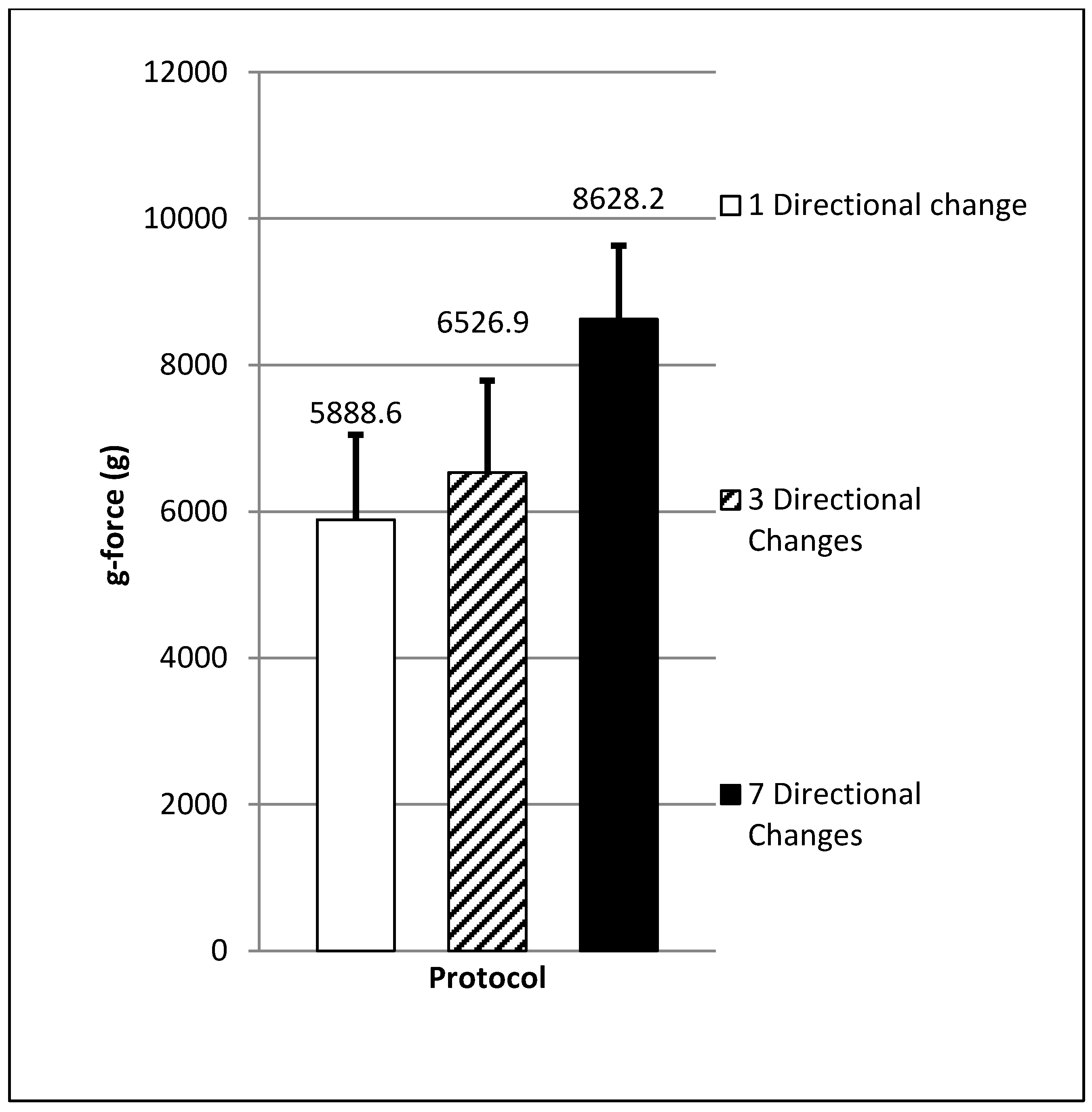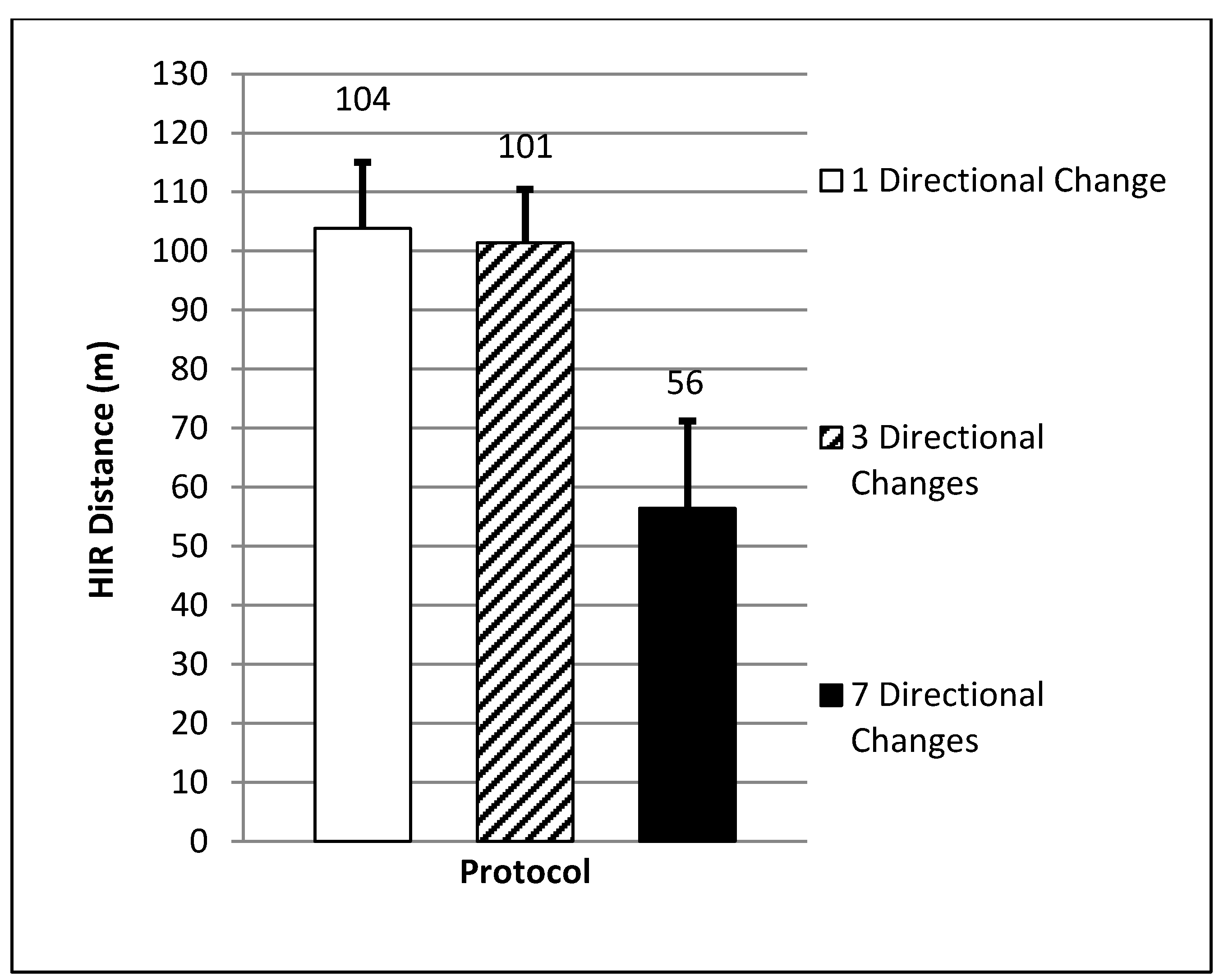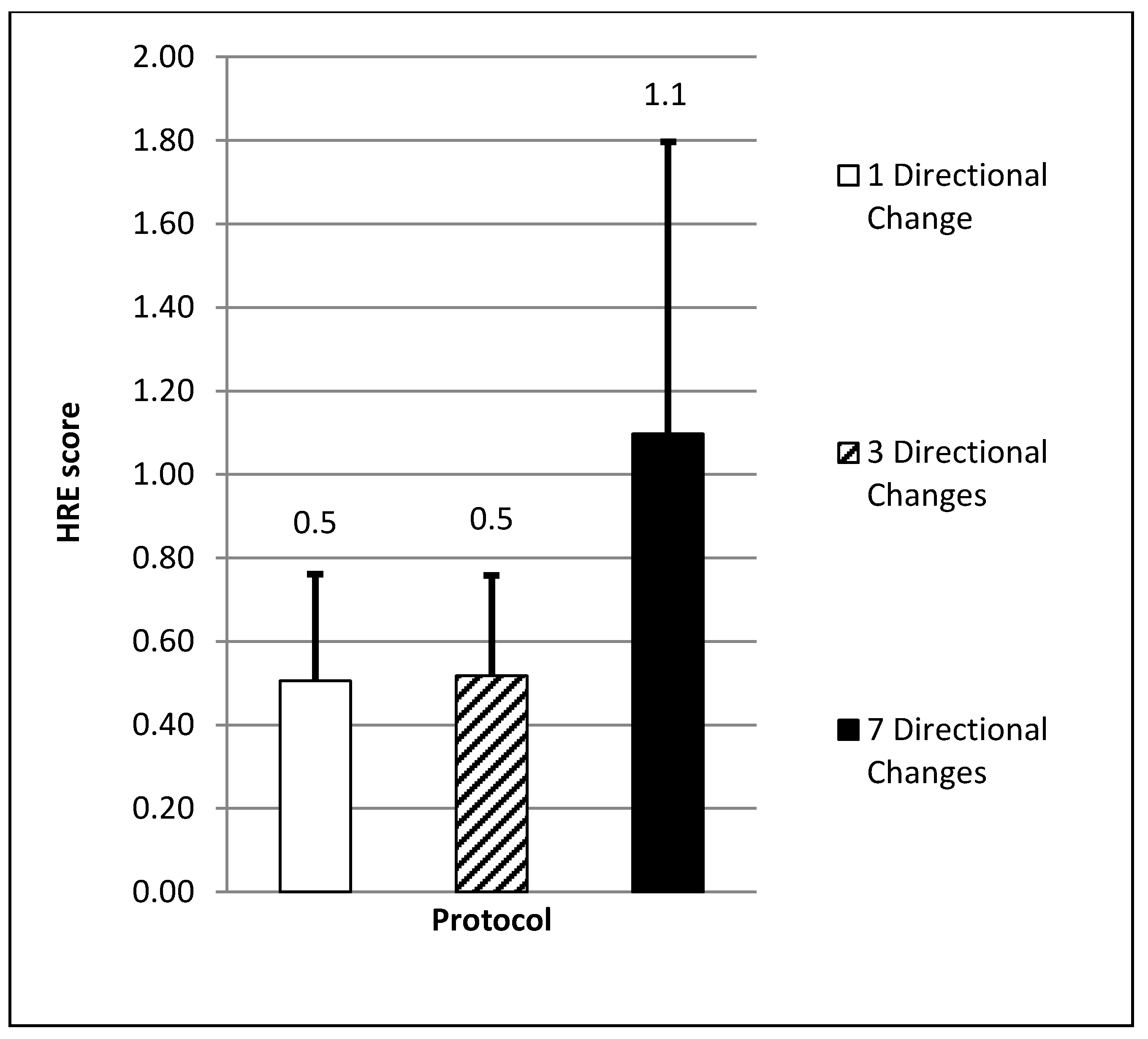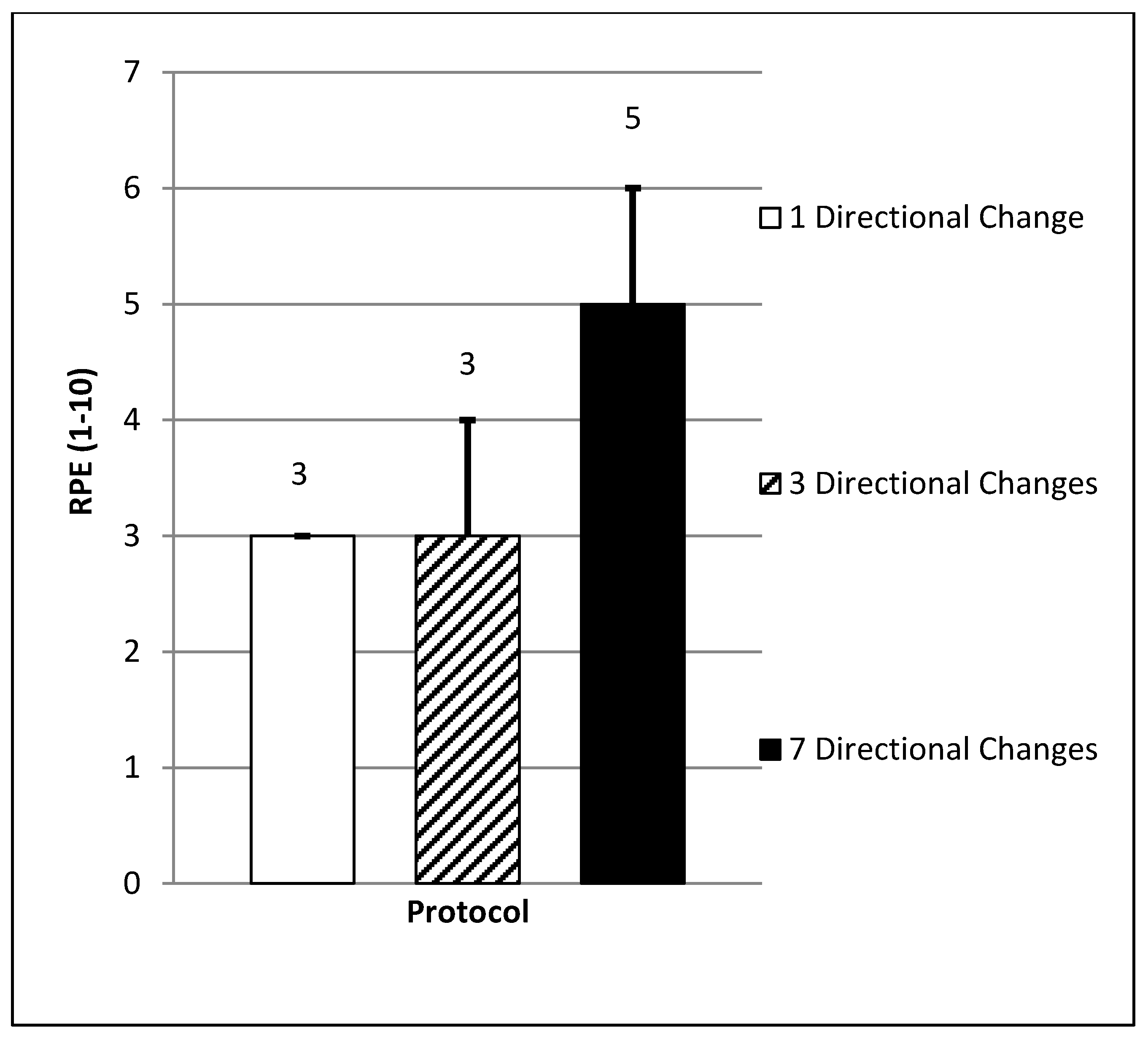Directional Change Mediates the Physiological Response to High-Intensity Shuttle Running in Professional Soccer Players
Abstract
1. Introduction
2. Methods
2.1. Subjects
2.2. Testing Procedures
2.3. Methodology
2.4. Statistical Analyses
3. Results
4. Discussion and Conclusions
Author Contributions
Conflicts of Interest
References
- Carling, C.; Dupont, G. Are declines in physical performance associated with a reduction in skill-related performance during professional soccer match-play? J. Sports Sci. 2011, 29, 63–71. [Google Scholar] [CrossRef] [PubMed]
- Bradley, P.S.; Noakes, T.D. Match running performance fluctuations in elite soccer: Indicative of fatigue, pacing or situational influences? J. Sports Sci. 2013, 31, 1627–1638. [Google Scholar] [CrossRef] [PubMed]
- Mohr, M.; Krustrup, P.; Bangsbo, J. Fatigue in soccer: A brief review. J. Sports Sci. 2005, 23, 593–599. [Google Scholar] [CrossRef] [PubMed]
- Barnes, C.; Archer, D.T.; Hogg, B.; Bush, M.; Bradley, P.S. The evolution of physical and technical performance parameters in the English Premier League. Int. J. Sports Med. 2014, 35, 1095–1100. [Google Scholar] [CrossRef] [PubMed]
- Reilly, T. Motion analysis and physiological demands. In Science and Soccer, 2nd ed.; Reilly, T., Williams, A.M., Eds.; Routledge: Oxon, UK, 2003; pp. 59–72. ISBN 0-415-26231-3. [Google Scholar]
- Bloomfield, J.; Polman, R.; O’Donoghue, P. Deceleration movements performed during FA Premier League soccer matches (abstract). J. Sports Sci. Med. 2007, 6, 6. [Google Scholar]
- Osgnach, C.; Poser, S.; Bernardini, R.; Rinaldo, R.; Di Prampero, E. Energy cost and metabolic power in elite soccer: A new match analysis approach. Med. Sci. Sports Exerc. 2010, 42, 170–178. [Google Scholar] [CrossRef] [PubMed]
- Russell, M.; Sparkes, W.; Northeast, J.; Cook, C.J.; Love, T.D.; Bracken, R.M.; Kilduff, L.P. Changes in acceleration and deceleration capacity throughout professional soccer match-play. J. Strength Cond. Res. 2016, 30, 2839–2844. [Google Scholar] [CrossRef] [PubMed]
- Stevens, T.G.; De Ruiter, C.J.; van Maurik, D.; van Lierop, C.J.; Savelsbergh, G.J.; Beek, P.J. Measured and Estimated Energy Cost of Constant and Shuttle Running in Soccer Players. Med. Sci. Sports Exerc. 2015, 47, 1219–1224. [Google Scholar] [CrossRef] [PubMed]
- Akenhead, R.; French, D.; Thompson, K.G.; Hayes, P.R. The physiological consequences of acceleration during shuttle running. Int. J. Sports Med. 2015, 36, 302–307. [Google Scholar] [CrossRef] [PubMed]
- Zamparo, P.; Zadro, I.; Lazzer, S.; Beato, M.; Sepulcri, L. Energetics of shuttle runs: The effects of distance and change of direction. Int. J. Sports Physiol. Perform. 2014, 9, 1033–1039. [Google Scholar] [CrossRef] [PubMed]
- Hader, K.; Mendez-Villanueva, A.; Ahmaidi, S.; Williams, B.K.; Buchheit, M. Changes of direction during high-intensity intermittent runs: Neuromuscular and metabolic responses. BMC Sports Sci. Med. Rehabilit. 2014, 6, 2. [Google Scholar] [CrossRef] [PubMed]
- Buglione, A.; Di Prampero, P.E. The energy cost of shuttle running. Eur. J. Appl. Physiol. 2013, 113, 1535–1543. [Google Scholar] [CrossRef] [PubMed]
- Hatamoto, Y.; Yamada, Y.; Fujii, T.; Higaki, Y.; Kiyonaga, A.; Tanaka, H. A novel method for calculating the energy cost of turning during running. J. Sports Med. 2013, 4, 117–122. [Google Scholar] [CrossRef] [PubMed]
- Buchheit, M.; Haydar, B.; Hader, K.; Ufland, P.; Ahmaidi, S. Assessing running economy during field running with changes of direction: Application to 20 m shuttles. Int. J. Sports Physiol. Perform. 2011, 6, 380–395. [Google Scholar] [CrossRef] [PubMed]
- Dellal, A.; Keller, D.; Carling, C.; Chaouachi, A.; Wong, D.P.; Chamari, K. Physiological effects of directional changes in intermittent exercise in soccer players. J. Strength Cond. Res. 2010, 24, 3219–3226. [Google Scholar] [CrossRef] [PubMed]
- Hader, K.; Mendez-Villanueva, A.; Palazzi, D.; Ahmaidi, S.; Buchheit, M. Metabolic power requirement of change of direction speed in young soccer players: Not all is what it seems. PLoS ONE 2016, 11, e0149839. [Google Scholar] [CrossRef] [PubMed]
- Buchheit, M.; Haydar, B.; Ahmaidi, S. Repeated sprints with directional change: Do angles matter? J. Sports Sci. 2012, 30, 555–562. [Google Scholar] [CrossRef] [PubMed]
- Buchheit, M.; Bishop, D.; Haydar, B.; Nakamura, F.Y.; Ahmaidi, S. Physiological responses to shuttle repeated-sprint running. Int. J. Sports Med. 2010, 31, 402–409. [Google Scholar] [CrossRef] [PubMed][Green Version]
- Foster, C.; Hector, L.L.; Welsh, R.; Schrager, M.; Green, M.A.; Snyder, A.C. Effects of specific versus cross-training on running performance. Eur. J. Appl. Physiol. Occup. Physiol. 1995, 70, 367–372. [Google Scholar] [CrossRef] [PubMed]
- Varley, M.; Fairweather, I.; Aughey, R. Validity and reliability of GPS for measuring instantaneous velocity during acceleration, deceleration, and constant motion. J. Sports Sci. 2012, 30, 121–127. [Google Scholar] [CrossRef] [PubMed]
- Alexander, J.P.; Hopkinson, T.L.; Wundersitz, D.W.; Serpell, B.G.; Mara, J.K.; Ball, N.B. Validity of a wearable accelerometer device to measure average acceleration values during high-speed running. J. Strength Cond. Res. 2016, 30, 3007–3013. [Google Scholar] [CrossRef] [PubMed]
- Akenhead, R.; Nassis, G.P. Training load monitoring in high-level football: Current practice and perceptions. Int. J. Sports Physiol. Perform. 2016, 11, 587–593. [Google Scholar] [CrossRef] [PubMed]
- Statsports Technologies Ltd. Viper Metrics; Statsports: Louth, UK, 2012. [Google Scholar]
- Kelly, D.M.; Strudwick, A.J.; Atkinson, G.; Drust, B.; Gregson, W. The within-participant correlation between perception of effort and heart rate-based estimations of training load in elite soccer players. J. Sports Sci. 2016, 34, 1328–1332. [Google Scholar] [CrossRef] [PubMed]
- Hopkins, W.G. Spreadsheet for analysis of controlled trials with adjustment for a subject characteristics. Sportscience 2006, 10, 46–50. [Google Scholar]
- Hopkins, W.G. A Scale of Magnitudes for Effect Statistics. A New View of Statistics 2000. Retrieved 25 March 2018. Available online: http://www.sportsci.org/resource/stats/index.html (accessed on 20 March 2018).
- Nedergaard, N.J.; Kersting, U.; Lake, M.J. Using accelerometry to quantify deceleration during a high intensity soccer turning manoeuvre. J. Sports Sci. 2014, 32, 1897–1905. [Google Scholar] [CrossRef] [PubMed]
- Knuttgen, H.G.; Klaussen, K. Oxygen debt in short-term exercise with concentric and eccentric muscle contraction. J. Appl. Physiol. 1971, 30, 632–635. [Google Scholar] [CrossRef] [PubMed]
- Navalta, J.W. Physiological responses to downhill walking in older and younger individuals. J. Exerc. Physiol. 2004, 7, 45–51. [Google Scholar]
- Pivarnik, J.M.; Sherman, N.W. Responses of aerobically fit men and women to uphill/downhill walking and slow jogging. Med. Sci. Sports Exerc. 1990, 22, 127–130. [Google Scholar] [CrossRef] [PubMed]
- Robergs, R.A.; Wagner, D.R.; Skemp, K.M. Oxygen consumption and energy expenditure of level versus downhill running. J. Sports Med. Phys. Fit. 1997, 37, 168–174. [Google Scholar]
- Di Prampero, E.; Fusi, S.; Sepulcri, L.; Morin, J.B.; Belli, A.; Antonutto, G. Sprint running: A new energetic approach. J. Exp. Biol. 2005, 208, 2809–2816. [Google Scholar] [CrossRef] [PubMed]
- Cavagna, G.A.; Komarek, L.; Mazzoleni, S. The mechanics of sprint running. J. Physiol. 1971, 217, 709–721. [Google Scholar] [CrossRef] [PubMed]





| Total Running Distance | No. of Runs | Distance of Each Run | Protocol Duration | HIR Speed | No. of Decelerations | No. of Accelerations | |
|---|---|---|---|---|---|---|---|
| 1 DC | 144 m | 2 | 72 m | 25.5 s | 6 m/s | 1 | 2 |
| 3 DC | 144 m | 4 | 36 m | 28.5 s | 6 m/s | 3 | 4 |
| 7 DC | 144 m | 8 | 18 m | 34.5 s | 6 m/s | 7 | 8 |
© 2018 by the authors. Licensee MDPI, Basel, Switzerland. This article is an open access article distributed under the terms and conditions of the Creative Commons Attribution (CC BY) license (http://creativecommons.org/licenses/by/4.0/).
Share and Cite
Tang, R.; Murtagh, C.; Warrington, G.; Cable, T.; Morgan, O.; O’Boyle, A.; Burgess, D.; Morgans, R.; Drust, B. Directional Change Mediates the Physiological Response to High-Intensity Shuttle Running in Professional Soccer Players. Sports 2018, 6, 39. https://doi.org/10.3390/sports6020039
Tang R, Murtagh C, Warrington G, Cable T, Morgan O, O’Boyle A, Burgess D, Morgans R, Drust B. Directional Change Mediates the Physiological Response to High-Intensity Shuttle Running in Professional Soccer Players. Sports. 2018; 6(2):39. https://doi.org/10.3390/sports6020039
Chicago/Turabian StyleTang, Remy, Conall Murtagh, Giles Warrington, Tim Cable, Oliver Morgan, Andrew O’Boyle, Darren Burgess, Ryland Morgans, and Barry Drust. 2018. "Directional Change Mediates the Physiological Response to High-Intensity Shuttle Running in Professional Soccer Players" Sports 6, no. 2: 39. https://doi.org/10.3390/sports6020039
APA StyleTang, R., Murtagh, C., Warrington, G., Cable, T., Morgan, O., O’Boyle, A., Burgess, D., Morgans, R., & Drust, B. (2018). Directional Change Mediates the Physiological Response to High-Intensity Shuttle Running in Professional Soccer Players. Sports, 6(2), 39. https://doi.org/10.3390/sports6020039




